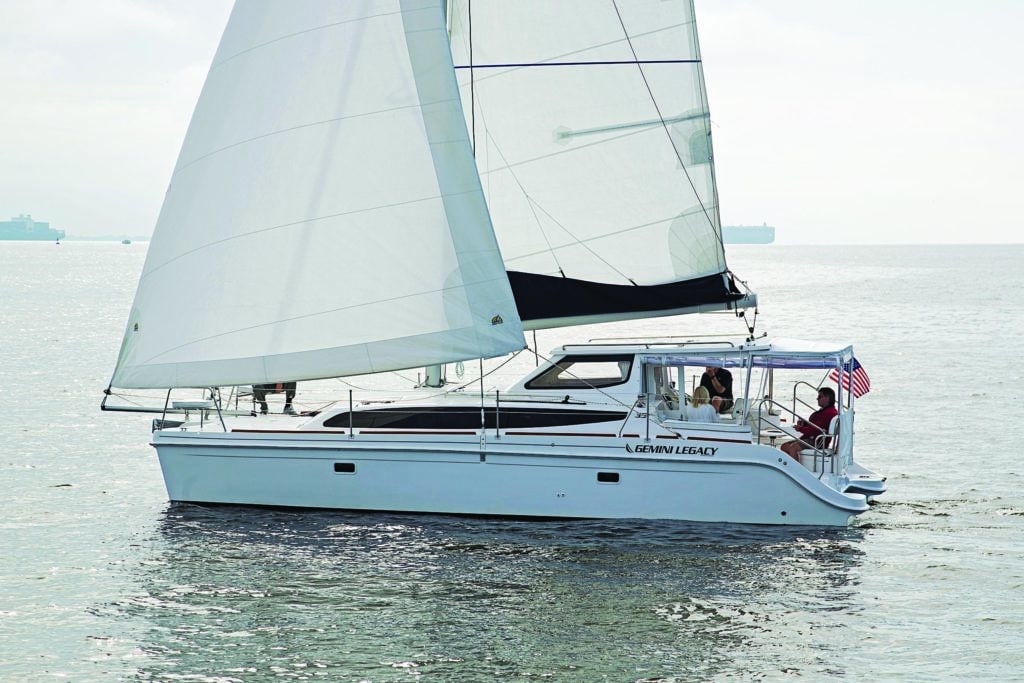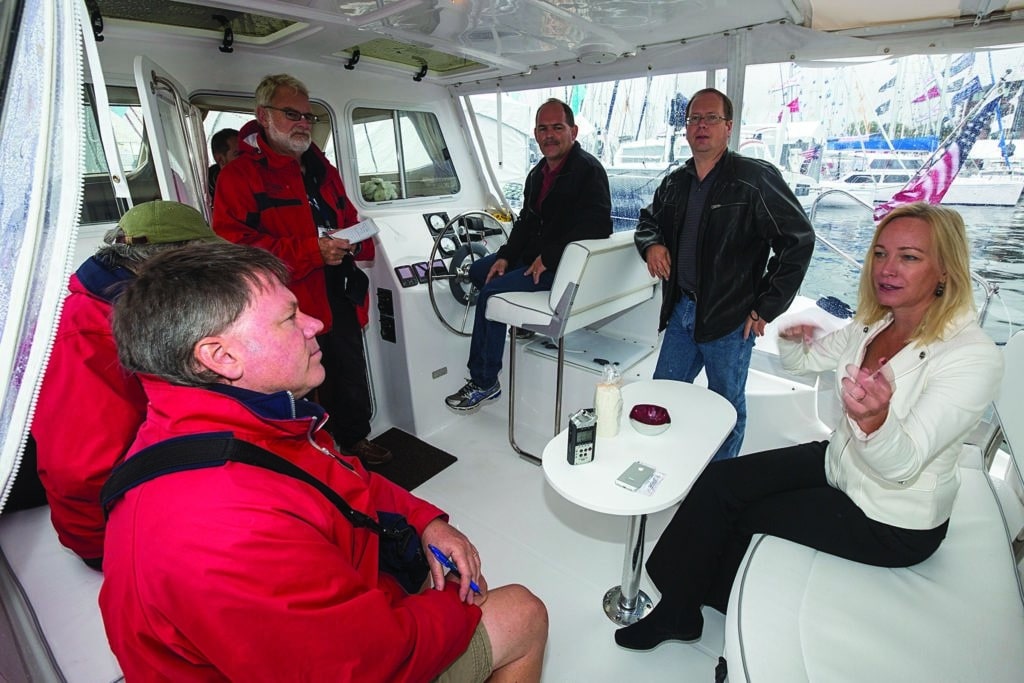A British Invasion
If it weren’t for a stretch of beautiful fall weather, America’s oldest continually operating builder of production cruising multihulls might have stayed in wet and rainy Britain. But fate intervened, as it has several times since for Tony Smith and his family-run business, and today more than 1,200 Gemini catamarans and scores more of the Telstar trimaran have been stamped “Made in the USA.” It’s a great American business story.
Early in the multihull era, Tony and his wife, Sue, set up shop in Britain as Performance Cruising, and in 1970 began building the Telstar. With its folding amas and shallow draft, the boat was popular with sailors cruising the tidal waters that surround parts of England, and the company took off. Two years later, Tony headed to the states, bringing his little cruiser to the U.S. Sailboat Show in Annapolis, Maryland.
In 1980, the English yacht market was in turmoil when Tony arrived here in America. His daughter, Laura Smith Hershfeld, says, “It was one of those crazy Annapolis boat shows where it’s 75 degrees, perfectly clear, and Annapolis is one of the most stunning places at that time of year.”
After the show, Tony took a drive. “He made his way down to Mayo, Maryland, about 20 miles south of Annapolis, and ended up at Casa Rio Marina,” recalls Laura. “There was a building that was the same size as the one he had in England, and it had a big ‘For Rent’ sign on it. He thought it was fate. He called my mother and said, ‘Pack ’em all up.’”
Boat molds were shipped, and the family followed. Soon Tony and a hired crew were laying up Telstars in the rented facility. All went well that first year, but then one day Tony was in his office, in another building at the boatyard, when he got a call from the marina telling him smoke was coming from his production shed. He rushed over, but by the time he got there, the fire was raging. Performance Cruising lost everything: all the molds, all the tools, all the boats in build. Authorities eventually determined that it was a case of arson. A fired worker’s pals, to retaliate, had mixed up a hot batch of epoxy and set it down next to a bucket full of acetone.
In the wake of the fire, the Smiths were crushed. “The decision was made to go home,” recalls Laura.
But then, as Tony and Sue sat in their office in shock, trying to decide what to do about the smoldering remains of their business, fate intervened once more. A fellow walked through the door and said he wanted a Telstar. When Tony told him that would be impossible, the guy asked if he could build him something else.
Smith family lore has it that the would-be customer declared, “I’ve heard of your reputation with multihulls. I want a multihull built by Tony Smith.” Laura adds with a laugh, “Now keep in mind, this is a story told by Tony Smith.”
By luck, before leaving England, Tony had bought a set of molds for the Aristocat catamaran. These had been shipped to the U.S. along with the Telstar molds, but had been stored in another building. Tony and a trustworthy worker who’d been kept on the payroll went to work. “A year later, we had a party for the launching of the very first Gemini catamaran, and it was called Phoenix,” says Laura.
By 1996, Performance Cruising had produced more than 500 of those early Geminis. That year, Tony designed a new boat, the Gemini 105M, from the ground up. It was a 33-foot, 6-inch family cruiser, and unique in the fact that with a 14-foot beam, it could fit into a conventional boat slip.
Demand for the 105M meant Performance Cruising needed more production space. A year later, in 1997, it moved into a new facility in Annapolis, on Back Creek. For the next decade, business was brisk. With a workforce of 50, Performance Cruising churned out four Geminis a month, and in 2005, Tony reprised the Telstar; they built two of those a month on the same production line.
The good times ground to a bruising halt, though, in the financial crisis of 2008. Soon it was decision time. Performance Cruising had a limited product line, the order book was slim, government regulations were increasing business costs, and then there was Tony, who had turned 65 and was looking forward to retirement. What to do?
Enter Hugh Murray. In 1989 he’d founded The Catamaran Company, which grew to be a powerhouse multihull dealership. Cat Co, as it’s called, became the dealer for Gemini, but times remained tough. In 2009, with no advance orders in sight, Laura and Hugh struck a deal to become partners. They closed the doors on Performance Cruising and formed a new company, Gemini Catamarans.
Hugh says that at the time, Cat Co was concentrating on selling 40-foot Lagoons at $400,000 to $500,000 a boat. Geminis were selling for about a third of that.
“When you graduate from school, you don’t go out and buy a 7 Series BMW; maybe you buy a 3 Series,” says Hugh. By buying into Gemini, Cat Co bought into a thousand or more potential customers.
Given the state of the economy, they knew they’d have to adapt to the times, and so they went looking for a builder with excess capacity but enough work of its own to have the purchasing power to build boats at a competitive price.
In the end, they threw their lot in with Hunter Marine, in part because it was a longtime American builder, but also because of its founder, the late Warren Luhrs. “That man had a way of looking at things and a vision. He looked at Gemini and he saw the potential without even being asked,” says Laura.
At Hunter, Gemini took advantage of Hunter’s R&D know-how to build an entirely new boat, the Gemini Legacy 35. Collaborators in its design included Laura and Tony, Warren Luhrs, and the Hunter design team.
In 2014, Gemini decided to investigate other options, and this time chose Catalina Yachts, also a long-standing American builder. The first Catalina-built Gemini was ready in time for this past winter’s Strictly Sail Miami boat show.
Catalina’s chief designer, Gerry Douglas, says taking on the catamarans has been a welcome addition, and that more workers have been hired because of it. Hull number seven is now in the molds, and Douglas says that when the line is fully ramped up, they’ll be prepared to build 24 cats a year.
“I think Gemini has sort of a sweet spot in the market,” notes Gerry. “They’re relatively affordable for a catamaran, and they’re of a size that’s not too intimidating to a couple, especially a couple coming from a monohull, as I think many of their customers do.”
When Gemini production moved to Hunter, the boats were built using Hunter’s trademark American cherry woodwork and included a lot of the hardware found throughout the Hunter line. At Catalina, the boats are fitted out with teak interiors and include fittings from the Catalina stockroom. This is good for both parties, says Laura. The company’s catamarans showcase the builder. At the same time, the builder can take advantage of economies of scale to keep prices down.
So what’s next? First on the list is to get Catalina’s production up to speed. And then? Well, Cat Co has a set of Manta catamaran hulls stored away. Already a couple of interested customers have put deposits in escrow to be the first to get one, should they be built. Manta is an old American brand, after all, and as fate would have it, Gemini is ready to try something new.
— Mark Pillsbury










